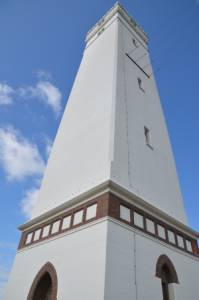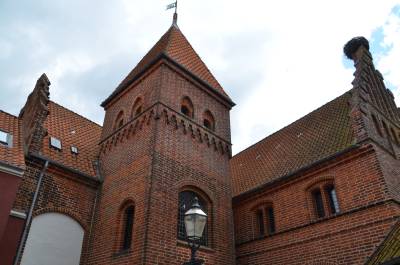Something in the eye of the beholder
 On this day, we were taking a trip from Varde. Our first goal was Blåvand, a
small village on the west coast. Or rather it was Blåvand Lighthouse and the
beach itself. From Varde to Blåvand Lighthouse was only a 30 minutes drive from
the hotel, so it was still early when we got there. We parked the car and walked
up to the lighthouse, but we didn't climb the stairs to the top - we don't like
to pay to climb stairs. But even the view from below the lighthouse was great.
The present lighthouse was built in 1900 and is still in use.
On this day, we were taking a trip from Varde. Our first goal was Blåvand, a
small village on the west coast. Or rather it was Blåvand Lighthouse and the
beach itself. From Varde to Blåvand Lighthouse was only a 30 minutes drive from
the hotel, so it was still early when we got there. We parked the car and walked
up to the lighthouse, but we didn't climb the stairs to the top - we don't like
to pay to climb stairs. But even the view from below the lighthouse was great.
The present lighthouse was built in 1900 and is still in use.
Picture on the left - Blåvand Lighthouse
After the visit to the lighthouse we walked past some German WW II bunkers to the top of a tall dune. From here we had a good view of the North Sea and in the distance we could see the offshore windmills on Horns Rev and a couple of service platforms as well. Most interesting though was the beach itself. Just below the lighthouse the coastline has a point, called Blåvands Huk. This is the westernmost point in Jylland. Of course we took pictures of the point, the lighthouse, the bunkers and the beach itself. Afterwards we returned to the car and continued our sightseeing. Just north of Blåvand the Danish army has a shooting range for guns and tanks, but there were no shootings on this day, so we could cross the area, on the only road leading through it. The area is on a heath called Kallemærsk Hede, a very interesing piece of nature. North of the heath we came to a small town, Henne. This is a vacation town like Søndervig, we had visisted the day before, further north on the coast. The town mostly lives from tourists, and consists of restaurants and shops, servicing these tourists, so we didn't stay for long.
Instead we headed north east, and passed through small villages with names like Nørre Nebel, Lunde and Kvong which all sounds strange, even in Danish. When we reached the highway between Ringkøbing and Ribe, we turned south towards the latter. Our next stop was supposed to be Ribe, but on the way we drove to Esbjerg, that used be a fishing town, but most, if not all, fishing vessels are gone by now, and the town thrives as a base for supply ships and helicopters for the oil industry in The North Sea. We also visited the small town of Bramming. I was here with my parents back in 1966 - yes, almost 50 years ago. At that time a famous sculpture was on the town square, and I wanted to see that again. Unfortunately it was gone though, so I had to make do with a picture of the local church. The sculpture was made out of used iron and steel by the local blacksmith Viggo Sørensen to prove, that he could make something just as artistic as the famous Danish sculpturer Robert Jacobsen.
We therefore continued to Ribe further south. This is considered to be the oldest town in Denmark, founded around 700 AD. The name itself comes from the old norse word, "ripa" that means "strip", and excavations has shown that the original settlement consisted of a lot of narrow strips of land leading inland from River Ribe Å. The settlement was probably designed like that to give everybody river access. There is a Viking Museum as well as a Viking Center in town, but we skipped both of those. Instead we found a place to leave our car on the outskirts of the historical downtown, and took a walk around. The oldest existing houses are from late medieval times, and the town is worth a visit. We were there in the easter of 2014 as well, but at that time we were in something of a hurry, so Tim wanted to take a closer look at the cathedral, and that became our first goal.
The cathedral was built between 1101 and 1134 on the spot, where it is supposed that Saint Ansgar built his church around 860 AD. The cathedral has three towers, all different. You can climb the tower called "Borgertårnet" (the citizens tower). We didn't climb it though, as we don't like to pay to climb stairs :-). We looked at the building from the outside before entering. Inside the cathedral it is not as interesting as the cathedral in Viborg in my opinion, but two kings are buried here - twice as many as in Viborg. The kings are Erik II Emune and Christoffer I. The town has an interesting legend though, only partly connected to the cathedral. In 1205 Princess Dagmar of Bohemia came to town. She was married to the Danish king Valdemar II Sejr (Sejr means Victory). In 1212 she died from complications from childbirth in the castle, now long gone, while her husband was away in Skanderborg around 135 kilometers (85 miles) away. When a message reached the king, that his wife were dying he immediately left for Ribe. According to an old folk ballad he took of with a 100 men, but he rode so fast, that when he reached Ribe, he was alone. Unfornately he didn't arrive in time, but when he entered the room, the queen woke from the dead to warn him not to marry Berengaria of Portugal as "she was a bitter tasting flower". In spite of the warning he actually did marry Berengaria two years later. Today the king is buried in St. Bendts Church in Ringsted on Sjælland, and the two queens are buried on each side of him. A nice story, but more legend than facts. It is true though that Dagmar died in Ribe after having given birth t a son, Valdemar III The Young, who was later killed by accident during a hunt in 1231. He too is buried in Ringsted.
Hans Tausen, known as the leading theologist of the Danish Reformation and Hans Adolph Brorson, a well known author of hymns were both bishops of the cathedral.

Old town hall of Ribe. Today a museum.
After the visit to the cathedral we walked around town looking at old houses like the old Town Hall, the old water works, the old jail, today serving as a hotel, where the rooms are converted cells. We also walked trough old streets with many old town houses. Finally we returned to the car and took off again. This time heading for Kammerslusen, a lock at the mouth of River Ribe Å. At this time one of Tim's eyes began stinging, and at first he thought it was from the cold, dry air from the airconditioning, so we shut it down, before continuing. At Kammerslusen there was not much to see. A pedestrian bridge normally crosses the river, but it had been taken down for repair. While Tim stayed in the car I climbed the dike and took some pictures. When I returned to the car, we continued. Shutting down the aircondition didn't help though, and Tim came up with another suggestion. Earlier in the day he had put on sunscreen, and now he figured that he may have rubbed is eyes, while there was still sunscreen on his hands, and it seems probable as the sting was gone the next day.
At that time though, it meant that he didn't feel like seeing anything in particular, so we just drove around the countryside, looking at whatever we passed. On out way we drove through small villages like Fole, Brændstrup, Langentved, Skovborg, Københoved, Malt, Askov og Rødding. The two last ones are known in Denmark for their folk high schools (no English word actually covers, what these places of education actually do). On our way, we crossed River Kongeåen, the border between Denmark and Germany from 1864 to 1920. North of Kongeåen, we visisted Skibelund Krat, that was a national gathering point in the years when Northschleswig was German. From here the people could look into what was once Danish lands. The last of the small villages was Malt, and from there we headed northeast towards Egtved, where the body of The Egtved Girl was discovered in 1921. She died around 1370 BC. We didn't look at the grave though as we did that in 2014. Just before Egtved we made a stop to look at a stone ship and some bronzeage mounds. The stone ship also contains a rune stone with the inscription "Tue son of Ravn made these runes for Vibrog his mother". Another rune stone close by has the inscription: Tue, Ravns son, and Funden and Gnyble, these three made the mound of Thyre, their queen." This is supposed to be the Thyre who was married to Gorm the Old, the first confirmed king of Denmark.
At this time we were driving on Hærvejen, which we followed for a while. When we reached a paved road though, we turned northwest though, heading for a small village called Hodde. On the map Tim had discovered that in the village was a museum of country schools, that he would like to see. On our way we passed through other small villages, and in one of these we saw a railway track that looked like it hadn't been used for years, which was later confirmed, when we got access to the internet. Another small village is Vorbasse. In Denmark this village was made famous in the beginning of the 20th century by a famous Danish performer, who called himself Professor Labri. In many of his perfomances he referred to "The Naval Port of Vorbasse", which by the way is at least 20 miles from the closest ocean of any kind. Today a model warship is moored in a small pond in the village. When we got to Hodde the museum was closed, and as Tim's eye was still bothering him, we decided to call it a day and returned to Varde.
We ended the day with dinner at an Italian Restaurant, and Tim still claims, that the tortelini he ate, was the best meal on the whole trip. I had something else, but is was good as well.